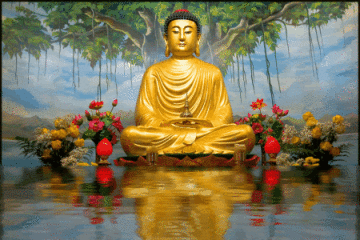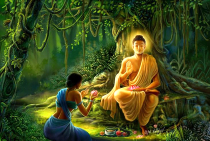
What Is Buddhism?
Buddhism Today
For over 2,600 years, Buddhism has served as a fundamental source of inspiration for numerous advanced civilisations, underpinning significant cultural achieve-ments and providing a profound framework for understanding the purpose of life for millions. In the present day, numerous individuals from varied backgrounds across the globe engage with the distinctive teachings of the Buddha. Thus, what precisely are these teachings?
.
The Teachings of the Buddha
Upon achieving Enlightenment, the Buddha dedicated the subsequent 45 years to imparting a pathway adherent to which individuals, irrespective of race, class, or gender, may also attain Perfect Enlightenment. The principles governing this pathway are referred to as the Dharma, which translates to "the nature of all things" or "the truth underlying existence." While it is not feasible within this brief overview to provide an exhaustive exploration of all these teachings, the following seven topics will encapsulate the essence of the Buddha's instruction:
1. The way of Inquiry
The Buddha emphatically cautioned against the perils of blind faith, advocating instead for a path of critical inquiry. In one of his most renowned discourses, the Kalama Sutra, he elucidated the risks associated with forming beliefs based solely on hearsay, tradition, popular consensus, the authority of ancient texts, assertions from supernatural entities, or trust in teachers, elders, or religious leaders. He advised that individuals should maintain an open mind and diligently examine their own lived experiences. When one observes that a particular perspective is consistent with both personal experience and rational thought, and fosters the well-being of oneself and others, it is prudent to adopt that perspective and embody its principles.
This framework is equally applicable to the Buddha’s own teachings, which merit careful consideration and scrutiny through the clarity of mind cultivated by meditation. Only when one directly apprehends these teachings through insights gained in meditation do they transcend into personal truth, offering profound liberation. Moreover, the seeker of knowledge must cultivate the virtue of tolerance. It is important to clarify that tolerance does not equate to the uncritical acceptance of every viewpoint. Rather, it involves refraining from anger towards ideas that one finds difficult to accept. In the course of one’s journey, concepts that were once met with scepticism may later be recognised as valid. Thus, in the spirit of open and respectful inquiry, the following outlines some fundamental teachings as articulated by the Buddha.
2. The Four Noble Truths
The principal teaching of the Buddha does not engage with philosophical enquiries concerning the existence of a Creator God, the origins of the cosmos, or the notion of a paradisiacal afterlife. Rather, it is fundamentally grounded in the tangible reality of human suffering and the pressing imperative to attain enduring relief from all manifestations of discontent. The Buddha illustrated this concept with the metaphor of an individual struck by a poison-tipped arrow, who, prior to seeking medical assistance, insists on identifying the shooter, the manufacture of the arrow, and other irrelevant details.
Such a person, engrossed in trivial inquiries, would undoubtedly succumb to their injury before receiving appropriate care. Similarly, the Buddha posited, "The paramount necessity of our existence is to secure lasting alleviation from the persistent suffering that deprives us of happiness and engenders strife." Philosophical speculation, therefore, occupies a position of secondary significance and is best approached only after one has sufficiently cultivated the mind through meditation to the extent that enables lucid examination and personal discovery of the truth.
Thus, the central Teaching of the Buddha, around which all other teachings revolve is the Four Noble Truths:
1. That all forms of being, human and otherwise, are afflicted with suffering.
2. That the cause of this suffering is Craving, born of the illusion of a soul.
3. That this suffering has a lasting end in the Experience of Enlightenment (Nirvana) which is the complete letting go of the illusion of soul and all consequent desire and aversion.
4. That this peaceful and blissful Enlightenment is achieved through a gradual training, a Path which is called the Middle Way or the Eightfold Path.
Two Main Schools of Buddhism Facts
The real followers of the Buddha can practise this religion without adhering to any school or sect.
A few hundred years after the Buddha's passing away, there arose eighteen different schools or sects all of which claimed to represent the original Teachings of the Buddha. The differences between these schools were basically due to various interpretations of the Teachings of the Buddha. Over a period of time, these schools gradually merged into two main schools: Theravada and Mahayana. Today, a majority of the followers of Buddhism are divided into these two schools.
Basically Mahayana, especially Tibetan Buddhism grew out of the Buddha's teaching that each individual carries within himself the potential for Buddhahood. Theravadins say that this potential can be realized through individual effort. Mahayanists, on the other hand, believe that they can seek salvation through the intervention of other superior beings called Bodhisattas. According to them, Bodhisattas are future Buddhas who, out of compassion for their fellow human beings, have delayed their own attainment of Buddhahood until they have helped others towards liberation. In spite of this basic difference, however, it must be stressed that doctrinally there is absolutely no disagreement concerning the Dhamma as contained in the sacred Tripitaka texts. Because Buddhists have been encouraged by the Master to carefully inquire after the truth, they have been free to interpret the scriptures according to their understanding. But above all, both Mahayana and Theravada are one in their reverence for the Buddha. (For a short, excellent exposition on this topic, read Dr. W. Rahula, 'Theravada and Mahayana Buddhism', published by The Buddhist Missionary Society.)
The areas of agreement between the two schools are as follows:
-
Both accept Sakyamuni Buddha as the Teacher.
-
The Four Noble Truths are exactly the same in both schools.
-
The Eightfold Path is exactly the same in both schools.
-
The Pattica-Samuppada or teaching on Dependent Origination is the same in both schools.
-
Both reject the idea of a supreme being who created and governed this world.
-
Both accept Anicca, Dukkha, Anatta and Sila, Samadhi, Panna without any difference.
Some people are of the view that Theravada is selfish because it teaches that people should seek their own salvation. But how can a selfish person gain Enlightenment? Both schools accept the three Yana or Bodhi and consider the Bodhisatta Ideal as the highest. The Mahayana has created many mystical Bodhisattas, while the Theravada believes that a Bodhisatta is a man amongst us who devotes his entire life for the attainment of perfection, and ultimately becomes a fully Enlightened Buddha for the well-being and happiness of the world.
The terms Hinayana (Small Vehicle) and Mahayana (Great Vehicle) are not known in the Theravada Pali literature. They are not found in the Pali Canon (Tripitaka) or in the Commentaries on the Tripitaka.
Theravada Buddhists follow orthodox religious traditions that had prevailed in India two thousand five hundred years ago. They perform their religious services in the Pali language. They also expect to attain the final goal (Nirvana) by becoming a Supreme Enlightened Buddha, Pacceka Buddha, or an Arahant (the highest stage of sainthood). The Majority of them prefer the Arahantahood. Buddhists in Sri Lanka, Burma, and Thailand belong to this school. Mahayanists have changed the old religious customs. Their practices are in accordance with the customs and traditions of the countries where they live. Mahayanists perform their religious services in their mother tongue. They expect to attain the final goal (Nibbana) by becoming Buddhas. Hence, they honor both the Buddha and Bodhisatta (one who is destined to be a Buddha) with the same respect. Buddhists in China, Japan and Korea belong to this school. Most of those in Tibet and Mongolia follow another school of Buddhism which is known as Vajrayana. Buddhist scholars believe that this school inclines more towards the Mahayana sect.
It is universally accepted by scholars that the terms Hinayana and Mahayana are later invention. Historically speaking, the Theravada already existed long before these terms came into being. That Theravada, considered to be the original teaching of the Buddha, was introduced to Sri Lanka and established there in the 3rd century B.C., during the time of Emperor Asoka of India. At that time there was nothing called Mahayana.
Mahayana as such appeared much later, about the beginning of the Christian era. Buddhism that went to Sri Lanka, with its Tripitaka and Commentaries, in the 3rd Century B.C., remained there intact as Theravada, and did not come into the scene of the Hinayana-Mahayana dispute that developed later in India. It seems therefore not legitimate to include Theravada in either of these two categories. However, after the inauguration of the World Fellowship of Buddhists in 1950, well-informed people, both in the East and in the West, use the term Theravada, and not the term Hinayana, with reference to Buddhism prevalent in South-east Asian countries. There are still outmoded people who use the term "Hinayana". In fact, the Samdhi Nirmorcana Sutra (a Mahayana Sutra) clearly says that the Sravakayana -- Theravada, and the Mahayana constitute one Yana (ekayana) and that they are not two different and distinct 'vehicles'. Although different schools of Buddhism held different opinions on the teaching of the Buddha, they never had any violence or blood shed for more than two thousands years. This is the uniqueness of Buddhist tolerance.










